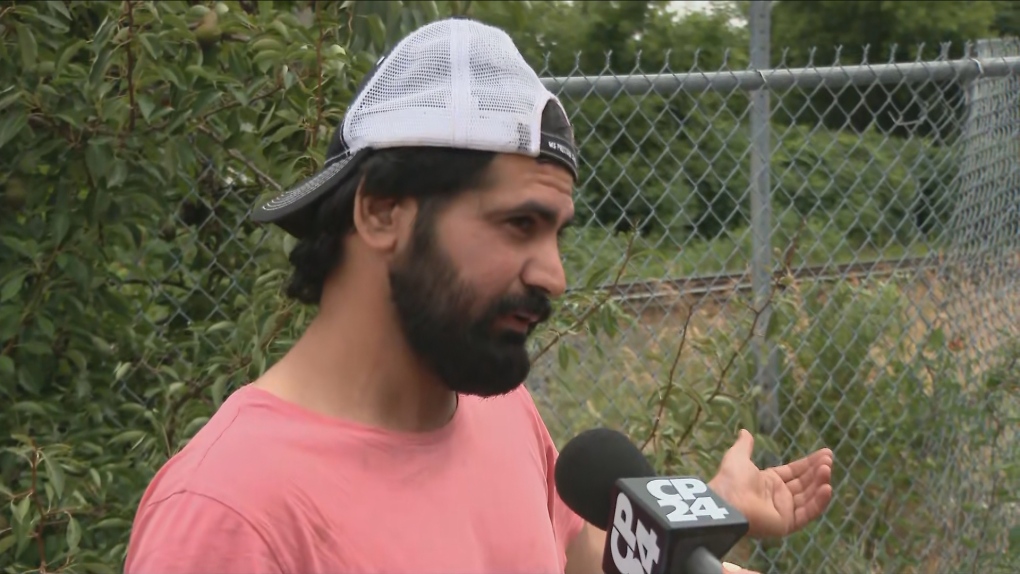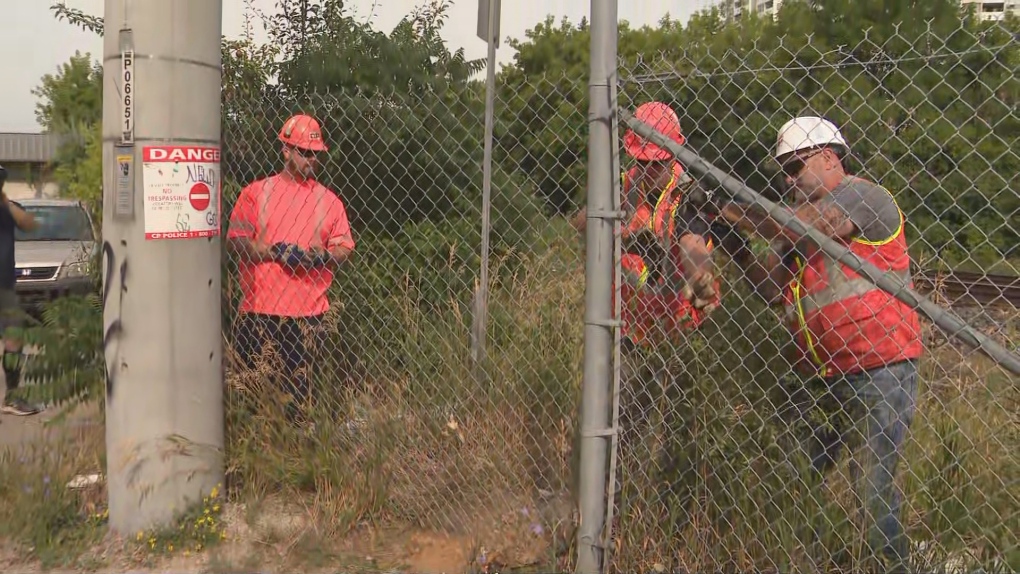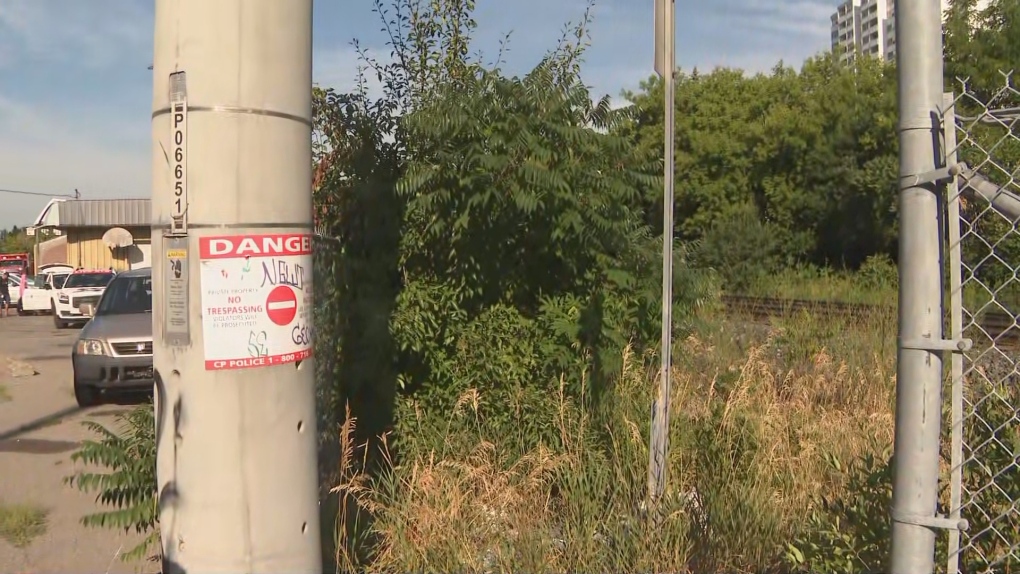Fencing installed near train tracks in Mississauga, Ont. day after child struck and killed
Crews were seen installing fencing near a set of train tracks in Mississauga, Ont. a little over 12 hours after a young girl was struck and killed by a GO Train in the area.
Emergency responders were called to the scene at Dundas Street and Cawthra Road at approximately 7:40 p.m. Tuesday.
Mississauga Fire first confirmed a child had been struck by a passing train. The child, who is believed to be four years old, was pronounced dead at the scene just before 9 p.m.
- Download our app to get local alerts to your device
- Get the latest local updates right to your inbox
The Transportation Safety Board of Canada (TSB) has confirmed they have launched an investigation into the crash, in addition to local police and provincial investigations.
A spokesperson for Metrolinx, which operates GO Train service, said in a statement that some 300 passengers were on board the train when the child was struck.
"Metrolinx is assisting with the investigation into this incident. That includes questions surrounding the protections around rail lines. There are many aspects to rail safety, and investigators will look at all the factors. Safety is always our top priority," James Wattie said in an email to CTV News Toronto Wednesday afternoon.
READ MORE: Child dead after being hit by GO Train in Mississauga, Ont.
Speaking to CP24 at the scene, a witness who owns a nearby garage said he was working at the time of the incident when he heard the blaring of train horns, followed by the loud screech of a railway brake.
“When I came out of my garage, I see the train stopped. This has never happened before,” Muhammad Tayyab said.
“Three kids was screaming and crying very loudly. I got shocked. I ran there... I see the body, there was one kid on the side…They were wounded very badly."
 Witness Muhammad Tayyab speaks to CP24 on July 27, 2022.
Witness Muhammad Tayyab speaks to CP24 on July 27, 2022.
Tayyab said he saw a woman running towards the children shortly afterwards and described her as being in complete shock.
It’s unclear how the child came to be in the path of the train at the time of the collision or where exactly they gained access to the tracks.
However, residents in the area who spoke to CP24 in the aftermath said the lack of barriers to the train tracks is a known issue and that it's not uncommon to see people crossing the tracks to get to the other side.
To that end, crews were seen erecting fencing Wednesday morning in an area near the tracks that appeared to be unobstructed.
 Crews install fencing near a section of train tracks in Mississauga, Ont. on July 27, 2022.
Crews install fencing near a section of train tracks in Mississauga, Ont. on July 27, 2022.
Previously, the only barrier restricting access to the tracks at that location was a “no trespassing” sign.
 An unobstructed area near a set of train tracks in Mississauga, Ont. is seen on July 27, 2022.
An unobstructed area near a set of train tracks in Mississauga, Ont. is seen on July 27, 2022.
The investigation into the crash is ongoing and this morning Ontario’s transportation minister, Caroline Mulroney, offered her condolences to the victim’s family.
“I have spoken with Metrolinx’s CEO, who has informed me that his team is assisting with the investigation underway,” Mulroney said in a tweet.
While police have not released the age of the child involved in the crash, Mississauga Mayor Bonnie Crombie said in a tweet published Tuesday night that she was “absolutely devastated” to hear of the “death of a young four-year-old.”
“The loss of a child is nothing short of a tragedy and my heart goes out to their family and loved ones as they grieve this indescribable and immeasurable loss,” Crombie wrote.
Flags at Mississauga city hall have since been lowered to half-mast.
Pamela Fuselli is the CEO of Parachute, a Canadian organization committed to injury prevention, and says there’s over 73,000 kilometres of railway tracks across Canada but that not all of it is closed off to the public.
“Not every space can be separated by fencing or barriers, unfortunately,” Fuselli said.
“In places where there is a high population, where there’s a high volume of potential crossing or people wanting to get from one side to the other, that needs to be taken into account.”
She said that understanding movement of people is key to preventing these tragedies and that “passive” precautionary measures, like fences and barriers, can help inform the public of where to cross safely.
With files from Joshua Freeman
CTVNews.ca Top Stories

BREAKING Canadian Union of Postal Workers issues 72-hour strike notice to Canada Post
The Canadian Union of Postal Workers has given a 72-hour strike notice to Canada Post.
Twin port shutdowns risk more damage to Canadian economy: business groups
Business groups are raising concerns about the broad effects of another round of labour disruptions in the transport sector as Canada faces shutdowns at its two biggest ports.
Northern Ontario teen recovering in hospital after being attacked; ex-boyfriend charged with attempted murder
Timmins-James Bay MP Charlie Angus was among approximately 120 people who gathered Sunday night for a candlelight vigil near the scene of a vicious attack against a 16-year-old in Cobalt.
Judge set to rule on whether to scrap Trump's conviction in hush money case
A judge is due to decide Tuesday whether to undo President-elect Donald Trump's conviction in his hush money case because of a U.S. Supreme Court ruling on presidential immunity.
Canada soccer icon Christine Sinclair leaves the pitch for the final time
Christine Sinclair played her final professional match Saturday night, capping off a career that saw the Canadian superstar win three professional league titles, an Olympic gold medal and finish with the most international goals, men or women, in soccer history.
CNN Trump picks Kristi Noem to serve as his Homeland Security secretary
President-elect Donald Trump has selected South Dakota Gov. Kristi Noem as his next secretary of the Department of Homeland Security, according to two people familiar with the selection.
As Toronto enters its Taylor Swift era, experts say crowd safety depends on planning
As Toronto readies for Taylor Swift’s arrival this week, some crowd management and planning experts say additional safety precautions should be taken when tens of thousands of fans fill the city's downtown core on show nights.
B.C. woman sentenced for stealing $14K in funds raised for schoolkids
A B.C. woman who stole more than $14,000 in volunteer-raised funds that were supposed to be spent on school supplies and programs – including hot meals for vulnerable kids – won't spend any time in jail.
Dr. Ronald Weiss, Ottawa's 'Wayne Gretzky' of vasectomies, dies
Dr. Ronald Weiss, who performed nearly 60,000 vasectomies on Ottawa men, establishing him as the "Wayne Gretzky" of the procedure, has died.































